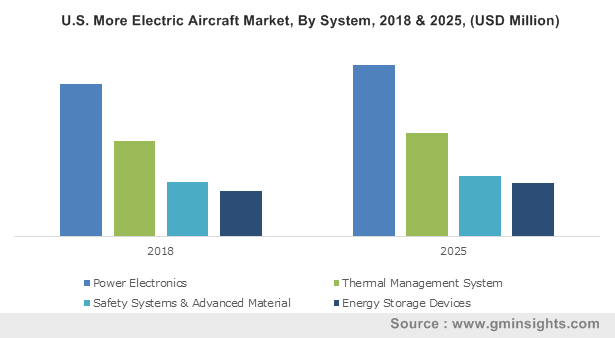Increased focus on emission control to fuel more electric aircraft market size
Publisher : Fractovia | Published Date : 2019-07-17Request Sample
Growing demand for lightweight, durable and fuel-efficient air carriers has advocated the importance of more electric aircraft market, along with the need for lower operating and maintenance costs. The substitution of conventional aircraft components including mechanical, hydraulic and pneumatic systems with electrical equipment offers optimized operational efficiency and invariably helps reduce carbon emissions. Increasing efforts to develop greener aircrafts will stimulate the aerospace sector to seek innovative ways for integrating additional electrical systems that enhance the airplane performance.
U.S. More Electric Aircraft Market, By System, 2018 & 2025, (USD Million)

Expanding tourism segment and subsequent increase in air traffic has encouraged major airplane manufacturers to not only grow their production capacity but also invest in novel technologies to boost performance. Global air passenger volume has surged across developed nations as well as emerging economies, coercing airlines to expand their fleets. In fact, in India the number of passengers opting for air transport in 2018 were about 12.5 million as against 11.5 million in the previous year. As worldwide commercial fleets witness a swift growth, more electric aircraft (MEA) industry will benefit from a booming customer base.
Regulatory bodies including Federal Aviation Administration (FAA), International Civil Aviation Organization (ICAO), and International Air Transport Association (IATA) are providing several regulatory policies and standards aimed at minimizing carbon emissions. This has added to the urgency of aircraft makers to incorporate single electric systems into planes instead of complex and heavy mechanical systems comprised of numerous individual parts. Simpler and lighter planes will lead to better fuel efficiency and help comply with upcoming emission mandates, besides ensuring long-term sustainability of airlines. Undoubtedly, regulatory compliance will be a key factor in strengthening more electric aircraft market outlook.
Boeing’s 787 no-bleed system is one of the leading technologies across air carriers in terms of more electric aircraft platforms in operation. It was built to enhance fuel as well as operational efficiency and involves the deployment of electrical systems instead of pneumatic systems, which delivers reduced lifecycle costs and lower weight. One of the major benefits of the no-bleed electrical system is the additional efficiency achieved in terms of fuel burn, as it has been proven to improve fuel savings by 3%, which is a substantial volume considering the huge amount of jet fuel used in one trip. The development has confirmed the massive demand potential to increase MEA market share from leading aircraft makers.
Safran Electrical & Power has introduced the COPPER Bird initiative under its new Clean Sky project for electrical characterization and testing. It is a modular tool that is completely reconfigurable and designed to focus on MEA concept. Basically, Safran has designed COPPER Bird to be used for validating innovative equipment and architectures used by air carrier manufacturers in their MEA research. Introduction and implementation of more such initiatives will bring tremendous transformation into aircraft manufacturing and outline the progress of MEA industry trends.
Over the past decade, electricity-based air carrier concepts have captured public imagination and become significantly popular worldwide. The advent of electric aircrafts has unlocked various new concepts of propulsion as opposed to traditional mechanisms. Recently, electric vertical take-off and landing mechanism had been tested by various leading firms globally, including Airbus. MEA systems being implemented in existing fuel-based aircrafts will certainly lead the way for the development of reliable and safe all-electric planes. Electric propulsion will uncover new challenges for aircraft designers and safety engineers, diverting their attention towards key advancements in MEA industry.
Apparently, with over 40,000 flights over U.S. daily, the air transport causes approximately 3% of annual carbon emissions in America, as well as a major fraction of air pollutants such as hydrocarbons and sulfur oxides. The region is home to aerospace giants like Boeing and Bombardier, in addition to having significant operations from European rivals like Airbus, all of which are striving to cut down on airplane emissions. R&D investments in US and Canada have surged in recent years, while growing defense expenditure has sustained constant need for innovations. Presence of notable technology companies involved in aircraft component manufacturing will further drive North America MEA market forecasts.
Consistent steps towards innovation and development of reliable electronic systems to perform vital functions like power management, air pressurization and flight control operations are anticipated to positively influence MEA industry. Ongoing projects like the COPPER Bird that enable European researchers to test and authenticate MEA architectures and systems will certainly complement emission control requirements. Reports estimate that global more electric aircraft market size will exceed USD 45 billion by 2025.